Holmes Institute HC2022: Marketing Research Report - Sky High Analysis
VerifiedAdded on 2023/04/04
|6
|1813
|303
Report
AI Summary
This report provides a market research analysis for Sky High Real Estate Developers, focusing on the changing family structure in Australia and its impact on the housing market. The study utilizes secondary data from sources like the Australian Bureau of Statistics to examine trends in family composition, dwelling types, and bedroom preferences. The research identifies a shift towards smaller families and a rise in single-parent households, leading to increased demand for apartments and flats with fewer bedrooms. The report recommends that Sky High Real Estate Developers adapt their offerings by constructing apartments with fewer bedrooms to cater to the evolving needs of the Australian market. The conclusion emphasizes the importance of modifying services to align with these changes, suggesting a focus on apartments with two or three bedrooms to maximize profitability and meet customer demands. The report highlights the need for real estate corporations to understand and respond to these market shifts effectively.
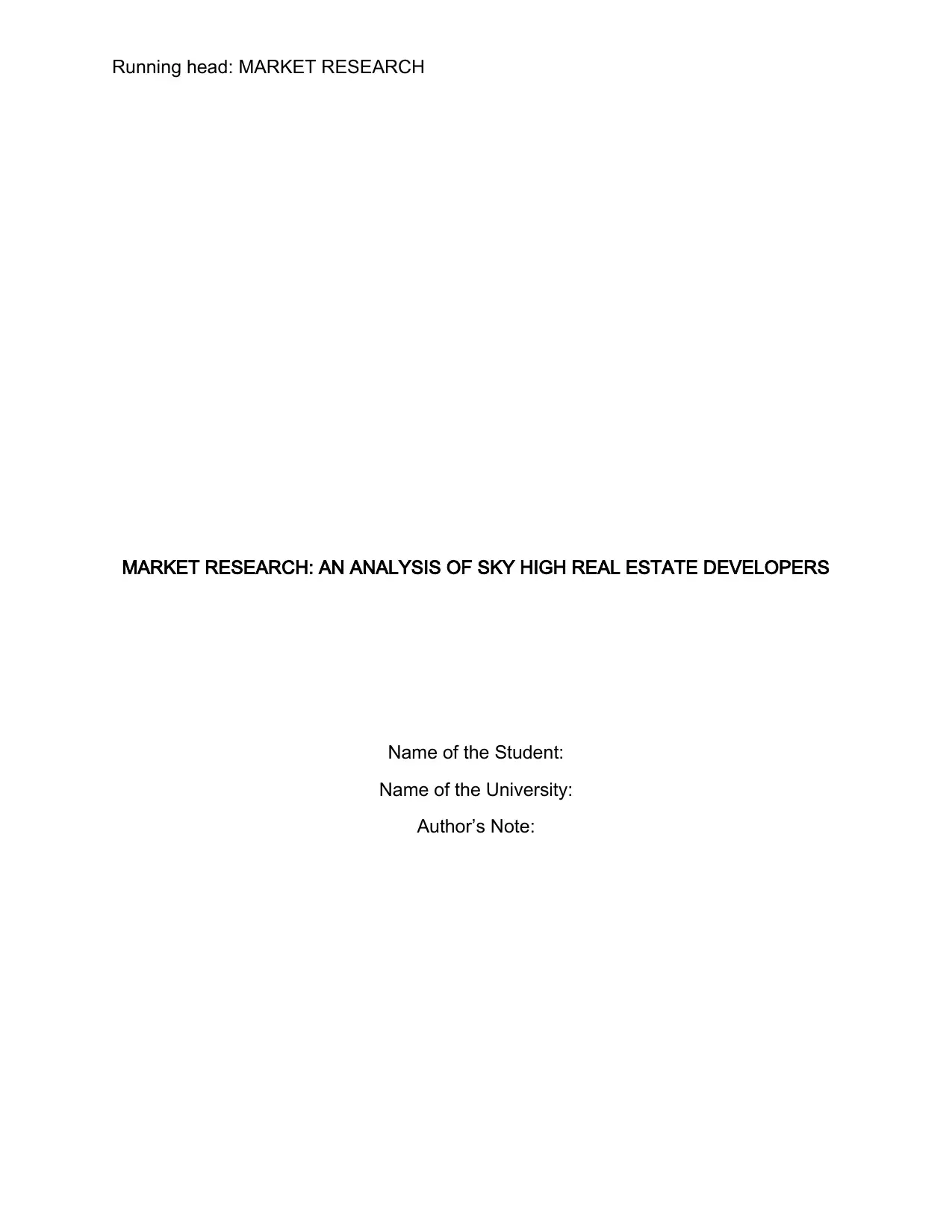
Running head: MARKET RESEARCH
MARKET RESEARCH: AN ANALYSIS OF SKY HIGH REAL ESTATE DEVELOPERS
Name of the Student:
Name of the University:
Author’s Note:
MARKET RESEARCH: AN ANALYSIS OF SKY HIGH REAL ESTATE DEVELOPERS
Name of the Student:
Name of the University:
Author’s Note:
Paraphrase This Document
Need a fresh take? Get an instant paraphrase of this document with our AI Paraphraser
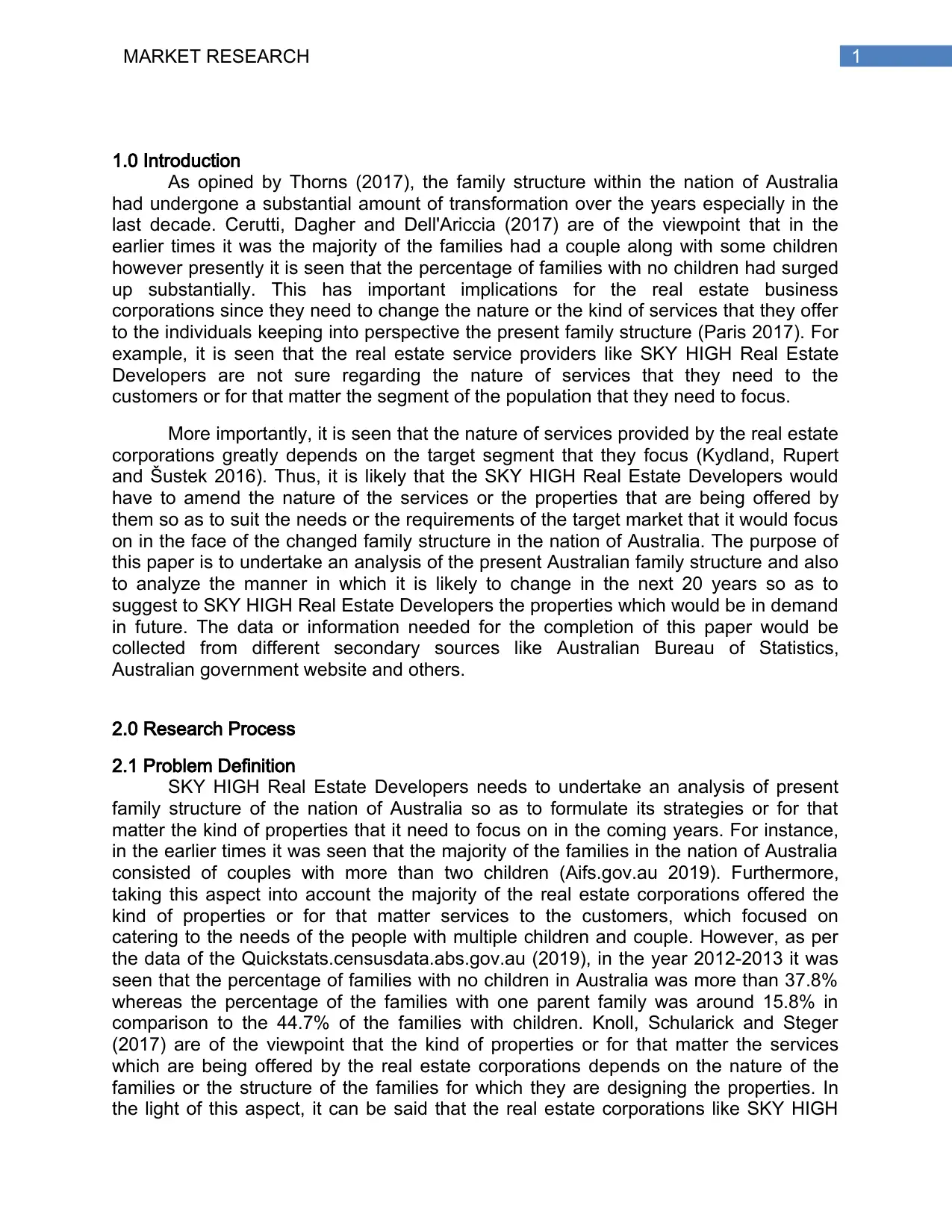
1MARKET RESEARCH
1.0 Introduction
As opined by Thorns (2017), the family structure within the nation of Australia
had undergone a substantial amount of transformation over the years especially in the
last decade. Cerutti, Dagher and Dell'Ariccia (2017) are of the viewpoint that in the
earlier times it was the majority of the families had a couple along with some children
however presently it is seen that the percentage of families with no children had surged
up substantially. This has important implications for the real estate business
corporations since they need to change the nature or the kind of services that they offer
to the individuals keeping into perspective the present family structure (Paris 2017). For
example, it is seen that the real estate service providers like SKY HIGH Real Estate
Developers are not sure regarding the nature of services that they need to the
customers or for that matter the segment of the population that they need to focus.
More importantly, it is seen that the nature of services provided by the real estate
corporations greatly depends on the target segment that they focus (Kydland, Rupert
and Šustek 2016). Thus, it is likely that the SKY HIGH Real Estate Developers would
have to amend the nature of the services or the properties that are being offered by
them so as to suit the needs or the requirements of the target market that it would focus
on in the face of the changed family structure in the nation of Australia. The purpose of
this paper is to undertake an analysis of the present Australian family structure and also
to analyze the manner in which it is likely to change in the next 20 years so as to
suggest to SKY HIGH Real Estate Developers the properties which would be in demand
in future. The data or information needed for the completion of this paper would be
collected from different secondary sources like Australian Bureau of Statistics,
Australian government website and others.
2.0 Research Process
2.1 Problem Definition
SKY HIGH Real Estate Developers needs to undertake an analysis of present
family structure of the nation of Australia so as to formulate its strategies or for that
matter the kind of properties that it need to focus on in the coming years. For instance,
in the earlier times it was seen that the majority of the families in the nation of Australia
consisted of couples with more than two children (Aifs.gov.au 2019). Furthermore,
taking this aspect into account the majority of the real estate corporations offered the
kind of properties or for that matter services to the customers, which focused on
catering to the needs of the people with multiple children and couple. However, as per
the data of the Quickstats.censusdata.abs.gov.au (2019), in the year 2012-2013 it was
seen that the percentage of families with no children in Australia was more than 37.8%
whereas the percentage of the families with one parent family was around 15.8% in
comparison to the 44.7% of the families with children. Knoll, Schularick and Steger
(2017) are of the viewpoint that the kind of properties or for that matter the services
which are being offered by the real estate corporations depends on the nature of the
families or the structure of the families for which they are designing the properties. In
the light of this aspect, it can be said that the real estate corporations like SKY HIGH
1.0 Introduction
As opined by Thorns (2017), the family structure within the nation of Australia
had undergone a substantial amount of transformation over the years especially in the
last decade. Cerutti, Dagher and Dell'Ariccia (2017) are of the viewpoint that in the
earlier times it was the majority of the families had a couple along with some children
however presently it is seen that the percentage of families with no children had surged
up substantially. This has important implications for the real estate business
corporations since they need to change the nature or the kind of services that they offer
to the individuals keeping into perspective the present family structure (Paris 2017). For
example, it is seen that the real estate service providers like SKY HIGH Real Estate
Developers are not sure regarding the nature of services that they need to the
customers or for that matter the segment of the population that they need to focus.
More importantly, it is seen that the nature of services provided by the real estate
corporations greatly depends on the target segment that they focus (Kydland, Rupert
and Šustek 2016). Thus, it is likely that the SKY HIGH Real Estate Developers would
have to amend the nature of the services or the properties that are being offered by
them so as to suit the needs or the requirements of the target market that it would focus
on in the face of the changed family structure in the nation of Australia. The purpose of
this paper is to undertake an analysis of the present Australian family structure and also
to analyze the manner in which it is likely to change in the next 20 years so as to
suggest to SKY HIGH Real Estate Developers the properties which would be in demand
in future. The data or information needed for the completion of this paper would be
collected from different secondary sources like Australian Bureau of Statistics,
Australian government website and others.
2.0 Research Process
2.1 Problem Definition
SKY HIGH Real Estate Developers needs to undertake an analysis of present
family structure of the nation of Australia so as to formulate its strategies or for that
matter the kind of properties that it need to focus on in the coming years. For instance,
in the earlier times it was seen that the majority of the families in the nation of Australia
consisted of couples with more than two children (Aifs.gov.au 2019). Furthermore,
taking this aspect into account the majority of the real estate corporations offered the
kind of properties or for that matter services to the customers, which focused on
catering to the needs of the people with multiple children and couple. However, as per
the data of the Quickstats.censusdata.abs.gov.au (2019), in the year 2012-2013 it was
seen that the percentage of families with no children in Australia was more than 37.8%
whereas the percentage of the families with one parent family was around 15.8% in
comparison to the 44.7% of the families with children. Knoll, Schularick and Steger
(2017) are of the viewpoint that the kind of properties or for that matter the services
which are being offered by the real estate corporations depends on the nature of the
families or the structure of the families for which they are designing the properties. In
the light of this aspect, it can be said that the real estate corporations like SKY HIGH
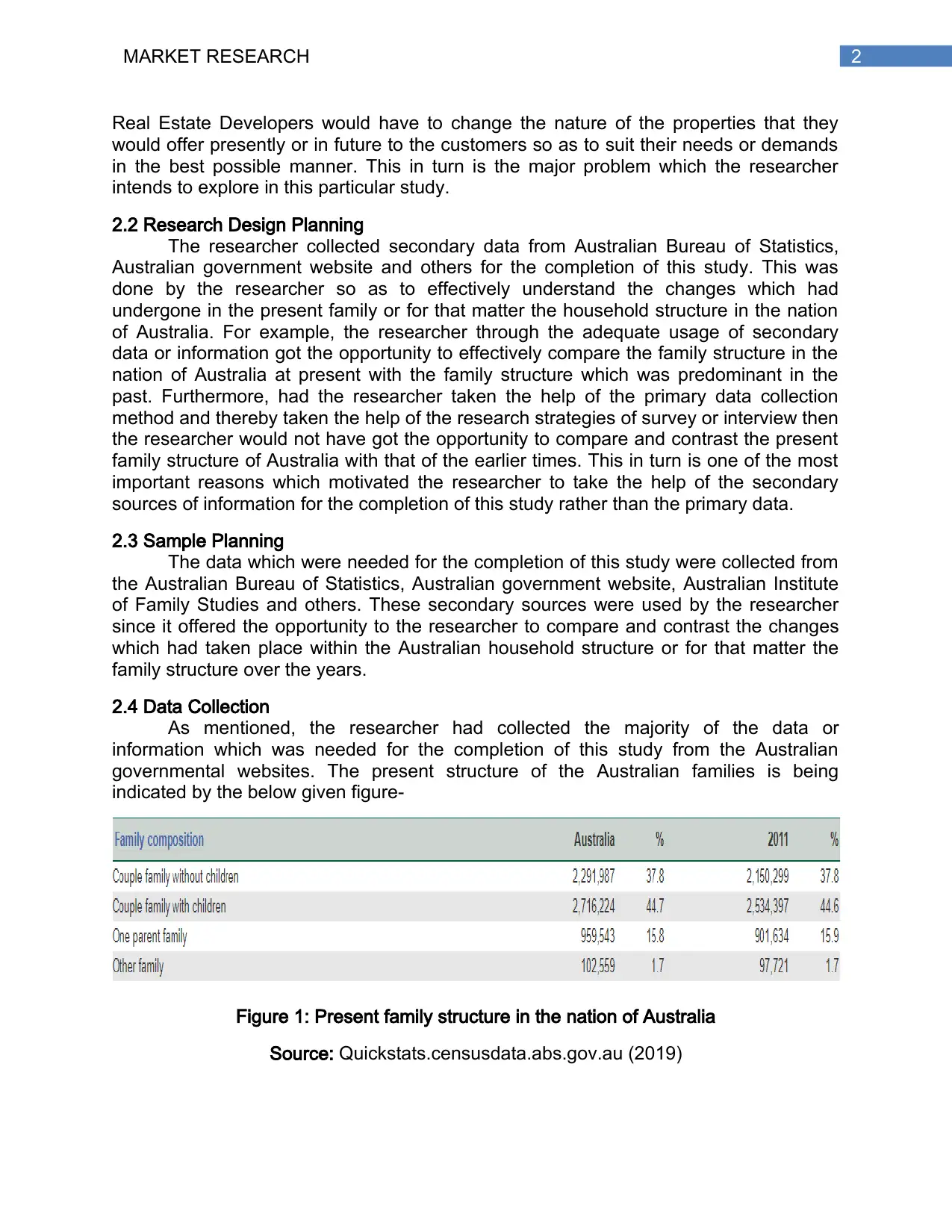
2MARKET RESEARCH
Real Estate Developers would have to change the nature of the properties that they
would offer presently or in future to the customers so as to suit their needs or demands
in the best possible manner. This in turn is the major problem which the researcher
intends to explore in this particular study.
2.2 Research Design Planning
The researcher collected secondary data from Australian Bureau of Statistics,
Australian government website and others for the completion of this study. This was
done by the researcher so as to effectively understand the changes which had
undergone in the present family or for that matter the household structure in the nation
of Australia. For example, the researcher through the adequate usage of secondary
data or information got the opportunity to effectively compare the family structure in the
nation of Australia at present with the family structure which was predominant in the
past. Furthermore, had the researcher taken the help of the primary data collection
method and thereby taken the help of the research strategies of survey or interview then
the researcher would not have got the opportunity to compare and contrast the present
family structure of Australia with that of the earlier times. This in turn is one of the most
important reasons which motivated the researcher to take the help of the secondary
sources of information for the completion of this study rather than the primary data.
2.3 Sample Planning
The data which were needed for the completion of this study were collected from
the Australian Bureau of Statistics, Australian government website, Australian Institute
of Family Studies and others. These secondary sources were used by the researcher
since it offered the opportunity to the researcher to compare and contrast the changes
which had taken place within the Australian household structure or for that matter the
family structure over the years.
2.4 Data Collection
As mentioned, the researcher had collected the majority of the data or
information which was needed for the completion of this study from the Australian
governmental websites. The present structure of the Australian families is being
indicated by the below given figure-
Figure 1: Present family structure in the nation of Australia
Source: Quickstats.censusdata.abs.gov.au (2019)
Real Estate Developers would have to change the nature of the properties that they
would offer presently or in future to the customers so as to suit their needs or demands
in the best possible manner. This in turn is the major problem which the researcher
intends to explore in this particular study.
2.2 Research Design Planning
The researcher collected secondary data from Australian Bureau of Statistics,
Australian government website and others for the completion of this study. This was
done by the researcher so as to effectively understand the changes which had
undergone in the present family or for that matter the household structure in the nation
of Australia. For example, the researcher through the adequate usage of secondary
data or information got the opportunity to effectively compare the family structure in the
nation of Australia at present with the family structure which was predominant in the
past. Furthermore, had the researcher taken the help of the primary data collection
method and thereby taken the help of the research strategies of survey or interview then
the researcher would not have got the opportunity to compare and contrast the present
family structure of Australia with that of the earlier times. This in turn is one of the most
important reasons which motivated the researcher to take the help of the secondary
sources of information for the completion of this study rather than the primary data.
2.3 Sample Planning
The data which were needed for the completion of this study were collected from
the Australian Bureau of Statistics, Australian government website, Australian Institute
of Family Studies and others. These secondary sources were used by the researcher
since it offered the opportunity to the researcher to compare and contrast the changes
which had taken place within the Australian household structure or for that matter the
family structure over the years.
2.4 Data Collection
As mentioned, the researcher had collected the majority of the data or
information which was needed for the completion of this study from the Australian
governmental websites. The present structure of the Australian families is being
indicated by the below given figure-
Figure 1: Present family structure in the nation of Australia
Source: Quickstats.censusdata.abs.gov.au (2019)
⊘ This is a preview!⊘
Do you want full access?
Subscribe today to unlock all pages.

Trusted by 1+ million students worldwide
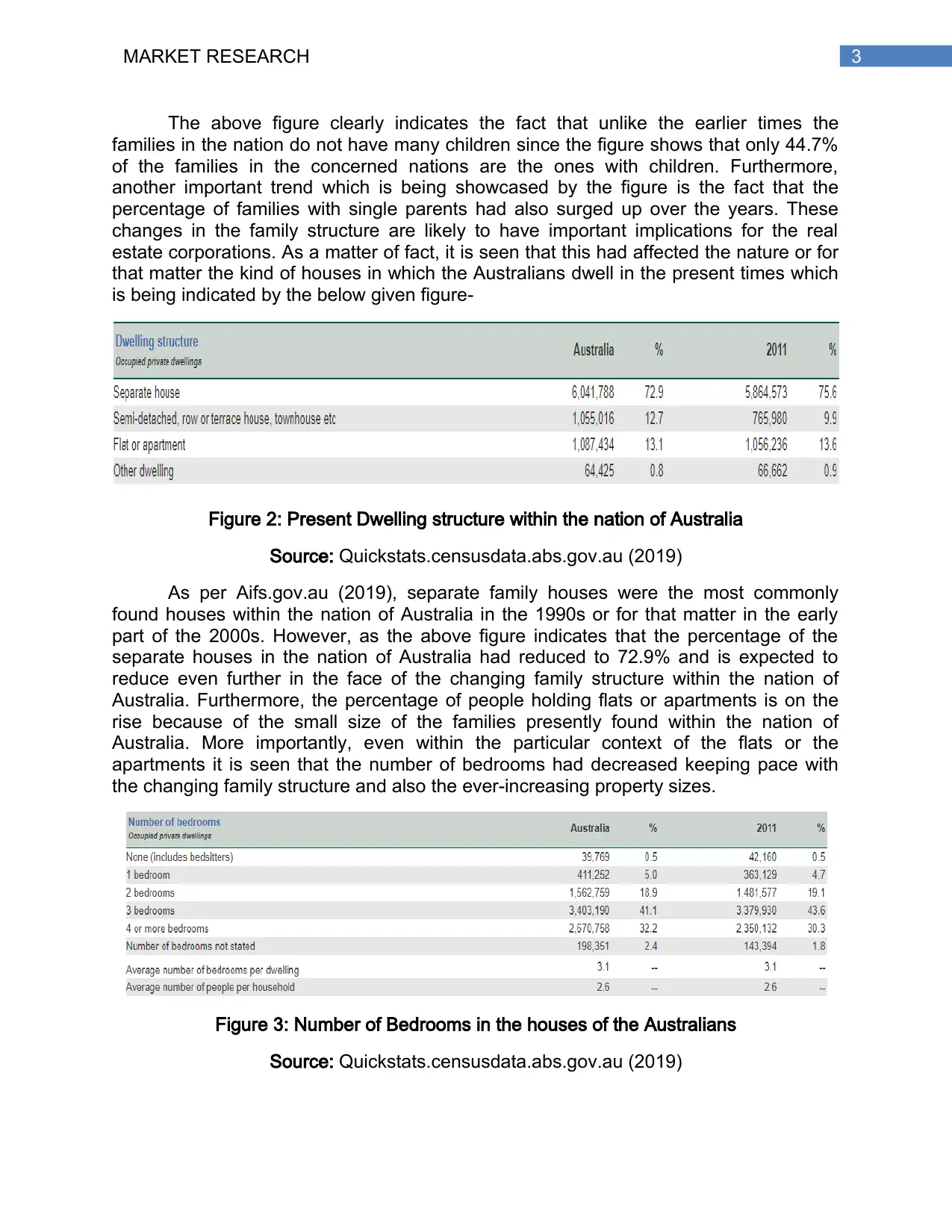
3MARKET RESEARCH
The above figure clearly indicates the fact that unlike the earlier times the
families in the nation do not have many children since the figure shows that only 44.7%
of the families in the concerned nations are the ones with children. Furthermore,
another important trend which is being showcased by the figure is the fact that the
percentage of families with single parents had also surged up over the years. These
changes in the family structure are likely to have important implications for the real
estate corporations. As a matter of fact, it is seen that this had affected the nature or for
that matter the kind of houses in which the Australians dwell in the present times which
is being indicated by the below given figure-
Figure 2: Present Dwelling structure within the nation of Australia
Source: Quickstats.censusdata.abs.gov.au (2019)
As per Aifs.gov.au (2019), separate family houses were the most commonly
found houses within the nation of Australia in the 1990s or for that matter in the early
part of the 2000s. However, as the above figure indicates that the percentage of the
separate houses in the nation of Australia had reduced to 72.9% and is expected to
reduce even further in the face of the changing family structure within the nation of
Australia. Furthermore, the percentage of people holding flats or apartments is on the
rise because of the small size of the families presently found within the nation of
Australia. More importantly, even within the particular context of the flats or the
apartments it is seen that the number of bedrooms had decreased keeping pace with
the changing family structure and also the ever-increasing property sizes.
Figure 3: Number of Bedrooms in the houses of the Australians
Source: Quickstats.censusdata.abs.gov.au (2019)
The above figure clearly indicates the fact that unlike the earlier times the
families in the nation do not have many children since the figure shows that only 44.7%
of the families in the concerned nations are the ones with children. Furthermore,
another important trend which is being showcased by the figure is the fact that the
percentage of families with single parents had also surged up over the years. These
changes in the family structure are likely to have important implications for the real
estate corporations. As a matter of fact, it is seen that this had affected the nature or for
that matter the kind of houses in which the Australians dwell in the present times which
is being indicated by the below given figure-
Figure 2: Present Dwelling structure within the nation of Australia
Source: Quickstats.censusdata.abs.gov.au (2019)
As per Aifs.gov.au (2019), separate family houses were the most commonly
found houses within the nation of Australia in the 1990s or for that matter in the early
part of the 2000s. However, as the above figure indicates that the percentage of the
separate houses in the nation of Australia had reduced to 72.9% and is expected to
reduce even further in the face of the changing family structure within the nation of
Australia. Furthermore, the percentage of people holding flats or apartments is on the
rise because of the small size of the families presently found within the nation of
Australia. More importantly, even within the particular context of the flats or the
apartments it is seen that the number of bedrooms had decreased keeping pace with
the changing family structure and also the ever-increasing property sizes.
Figure 3: Number of Bedrooms in the houses of the Australians
Source: Quickstats.censusdata.abs.gov.au (2019)
Paraphrase This Document
Need a fresh take? Get an instant paraphrase of this document with our AI Paraphraser
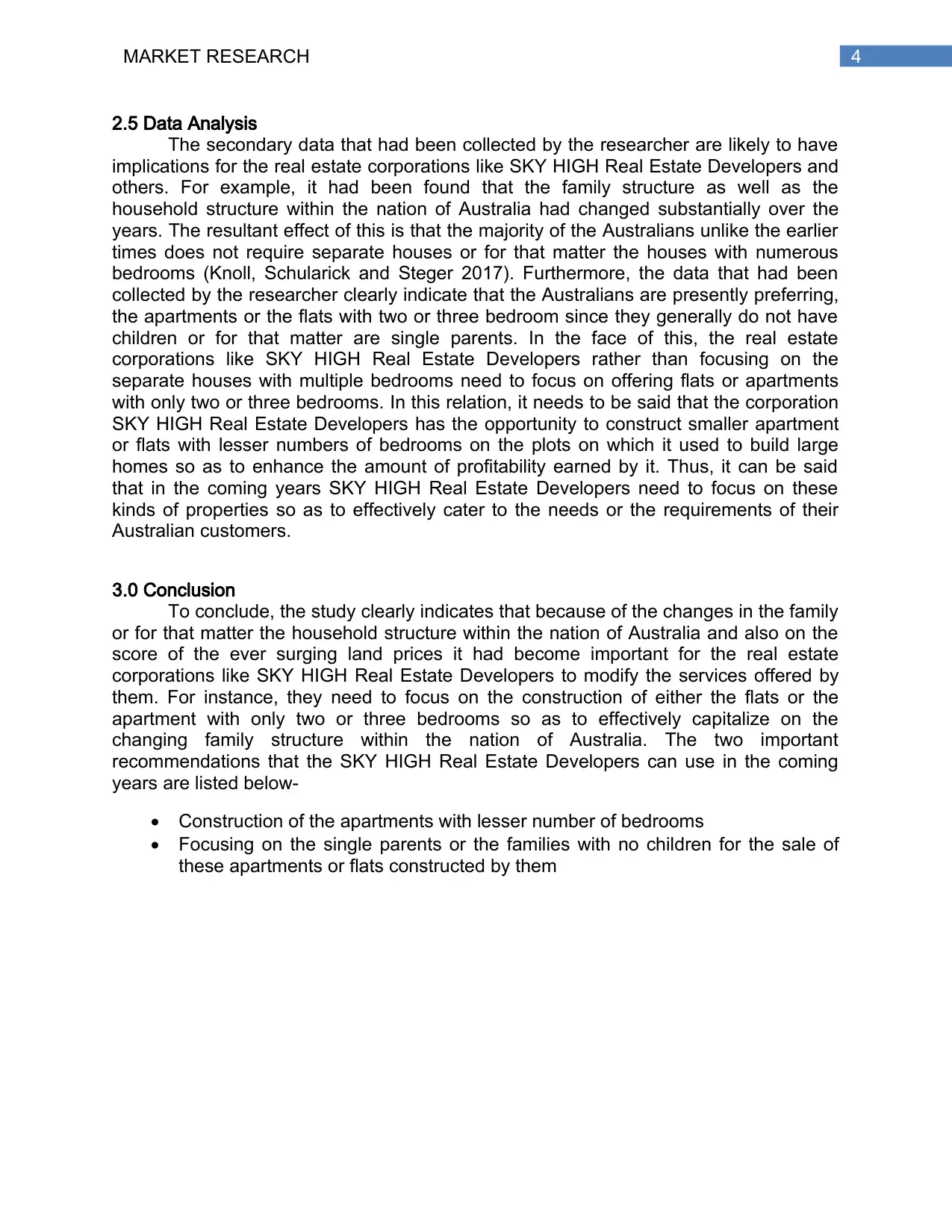
4MARKET RESEARCH
2.5 Data Analysis
The secondary data that had been collected by the researcher are likely to have
implications for the real estate corporations like SKY HIGH Real Estate Developers and
others. For example, it had been found that the family structure as well as the
household structure within the nation of Australia had changed substantially over the
years. The resultant effect of this is that the majority of the Australians unlike the earlier
times does not require separate houses or for that matter the houses with numerous
bedrooms (Knoll, Schularick and Steger 2017). Furthermore, the data that had been
collected by the researcher clearly indicate that the Australians are presently preferring,
the apartments or the flats with two or three bedroom since they generally do not have
children or for that matter are single parents. In the face of this, the real estate
corporations like SKY HIGH Real Estate Developers rather than focusing on the
separate houses with multiple bedrooms need to focus on offering flats or apartments
with only two or three bedrooms. In this relation, it needs to be said that the corporation
SKY HIGH Real Estate Developers has the opportunity to construct smaller apartment
or flats with lesser numbers of bedrooms on the plots on which it used to build large
homes so as to enhance the amount of profitability earned by it. Thus, it can be said
that in the coming years SKY HIGH Real Estate Developers need to focus on these
kinds of properties so as to effectively cater to the needs or the requirements of their
Australian customers.
3.0 Conclusion
To conclude, the study clearly indicates that because of the changes in the family
or for that matter the household structure within the nation of Australia and also on the
score of the ever surging land prices it had become important for the real estate
corporations like SKY HIGH Real Estate Developers to modify the services offered by
them. For instance, they need to focus on the construction of either the flats or the
apartment with only two or three bedrooms so as to effectively capitalize on the
changing family structure within the nation of Australia. The two important
recommendations that the SKY HIGH Real Estate Developers can use in the coming
years are listed below-
Construction of the apartments with lesser number of bedrooms
Focusing on the single parents or the families with no children for the sale of
these apartments or flats constructed by them
2.5 Data Analysis
The secondary data that had been collected by the researcher are likely to have
implications for the real estate corporations like SKY HIGH Real Estate Developers and
others. For example, it had been found that the family structure as well as the
household structure within the nation of Australia had changed substantially over the
years. The resultant effect of this is that the majority of the Australians unlike the earlier
times does not require separate houses or for that matter the houses with numerous
bedrooms (Knoll, Schularick and Steger 2017). Furthermore, the data that had been
collected by the researcher clearly indicate that the Australians are presently preferring,
the apartments or the flats with two or three bedroom since they generally do not have
children or for that matter are single parents. In the face of this, the real estate
corporations like SKY HIGH Real Estate Developers rather than focusing on the
separate houses with multiple bedrooms need to focus on offering flats or apartments
with only two or three bedrooms. In this relation, it needs to be said that the corporation
SKY HIGH Real Estate Developers has the opportunity to construct smaller apartment
or flats with lesser numbers of bedrooms on the plots on which it used to build large
homes so as to enhance the amount of profitability earned by it. Thus, it can be said
that in the coming years SKY HIGH Real Estate Developers need to focus on these
kinds of properties so as to effectively cater to the needs or the requirements of their
Australian customers.
3.0 Conclusion
To conclude, the study clearly indicates that because of the changes in the family
or for that matter the household structure within the nation of Australia and also on the
score of the ever surging land prices it had become important for the real estate
corporations like SKY HIGH Real Estate Developers to modify the services offered by
them. For instance, they need to focus on the construction of either the flats or the
apartment with only two or three bedrooms so as to effectively capitalize on the
changing family structure within the nation of Australia. The two important
recommendations that the SKY HIGH Real Estate Developers can use in the coming
years are listed below-
Construction of the apartments with lesser number of bedrooms
Focusing on the single parents or the families with no children for the sale of
these apartments or flats constructed by them
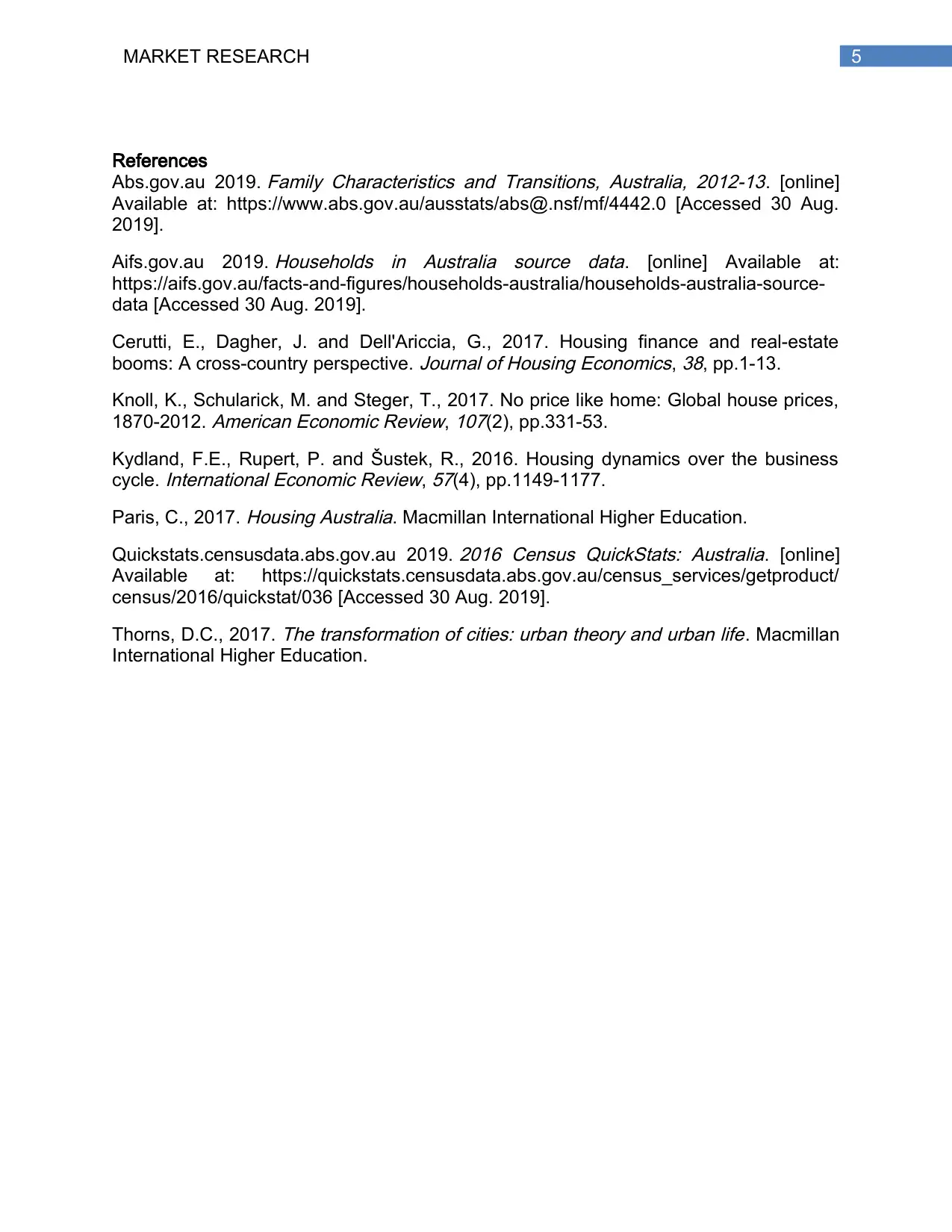
5MARKET RESEARCH
References
Abs.gov.au 2019.
Family Characteristics and Transitions, Australia, 2012-13. [online]
Available at: https://www.abs.gov.au/ausstats/abs@.nsf/mf/4442.0 [Accessed 30 Aug.
2019].
Aifs.gov.au 2019.
Households in Australia source data. [online] Available at:
https://aifs.gov.au/facts-and-figures/households-australia/households-australia-source-
data [Accessed 30 Aug. 2019].
Cerutti, E., Dagher, J. and Dell'Ariccia, G., 2017. Housing finance and real-estate
booms: A cross-country perspective.
Journal of Housing Economics,
38, pp.1-13.
Knoll, K., Schularick, M. and Steger, T., 2017. No price like home: Global house prices,
1870-2012.
American Economic Review,
107(2), pp.331-53.
Kydland, F.E., Rupert, P. and Šustek, R., 2016. Housing dynamics over the business
cycle.
International Economic Review,
57(4), pp.1149-1177.
Paris, C., 2017.
Housing Australia. Macmillan International Higher Education.
Quickstats.censusdata.abs.gov.au 2019.
2016 Census QuickStats: Australia. [online]
Available at: https://quickstats.censusdata.abs.gov.au/census_services/getproduct/
census/2016/quickstat/036 [Accessed 30 Aug. 2019].
Thorns, D.C., 2017.
The transformation of cities: urban theory and urban life. Macmillan
International Higher Education.
References
Abs.gov.au 2019.
Family Characteristics and Transitions, Australia, 2012-13. [online]
Available at: https://www.abs.gov.au/ausstats/abs@.nsf/mf/4442.0 [Accessed 30 Aug.
2019].
Aifs.gov.au 2019.
Households in Australia source data. [online] Available at:
https://aifs.gov.au/facts-and-figures/households-australia/households-australia-source-
data [Accessed 30 Aug. 2019].
Cerutti, E., Dagher, J. and Dell'Ariccia, G., 2017. Housing finance and real-estate
booms: A cross-country perspective.
Journal of Housing Economics,
38, pp.1-13.
Knoll, K., Schularick, M. and Steger, T., 2017. No price like home: Global house prices,
1870-2012.
American Economic Review,
107(2), pp.331-53.
Kydland, F.E., Rupert, P. and Šustek, R., 2016. Housing dynamics over the business
cycle.
International Economic Review,
57(4), pp.1149-1177.
Paris, C., 2017.
Housing Australia. Macmillan International Higher Education.
Quickstats.censusdata.abs.gov.au 2019.
2016 Census QuickStats: Australia. [online]
Available at: https://quickstats.censusdata.abs.gov.au/census_services/getproduct/
census/2016/quickstat/036 [Accessed 30 Aug. 2019].
Thorns, D.C., 2017.
The transformation of cities: urban theory and urban life. Macmillan
International Higher Education.
⊘ This is a preview!⊘
Do you want full access?
Subscribe today to unlock all pages.

Trusted by 1+ million students worldwide
1 out of 6
Related Documents
Your All-in-One AI-Powered Toolkit for Academic Success.
+13062052269
info@desklib.com
Available 24*7 on WhatsApp / Email
![[object Object]](/_next/static/media/star-bottom.7253800d.svg)
Unlock your academic potential
Copyright © 2020–2025 A2Z Services. All Rights Reserved. Developed and managed by ZUCOL.




